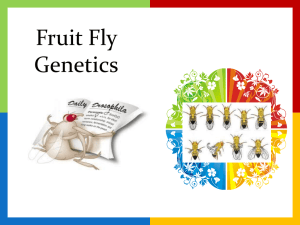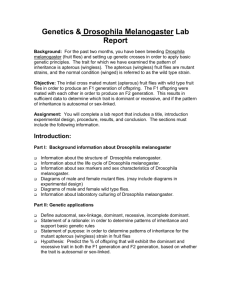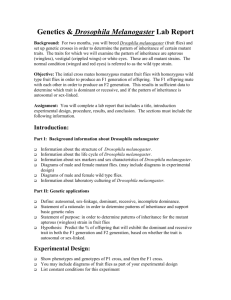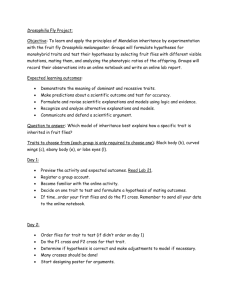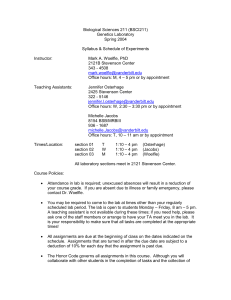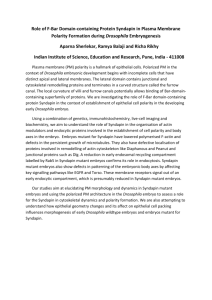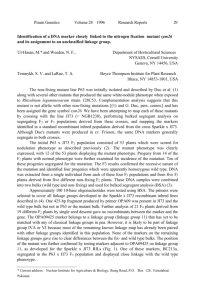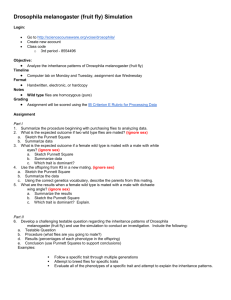Lab 5: Drosophila Linkage Map
advertisement
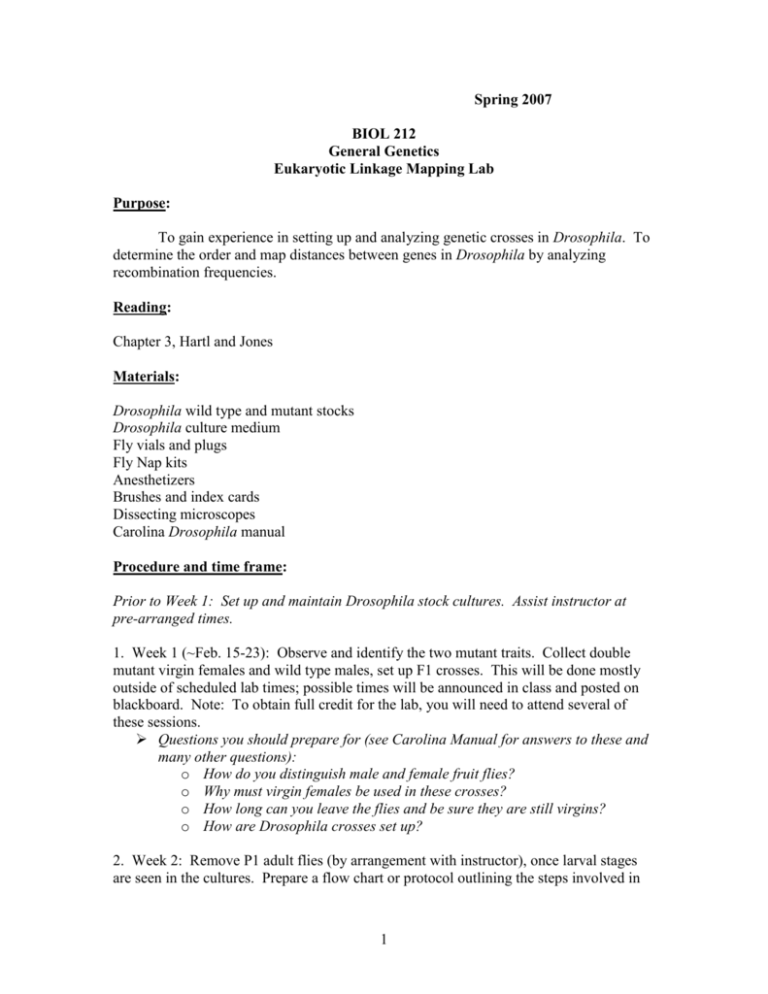
Spring 2007 BIOL 212 General Genetics Eukaryotic Linkage Mapping Lab Purpose: To gain experience in setting up and analyzing genetic crosses in Drosophila. To determine the order and map distances between genes in Drosophila by analyzing recombination frequencies. Reading: Chapter 3, Hartl and Jones Materials: Drosophila wild type and mutant stocks Drosophila culture medium Fly vials and plugs Fly Nap kits Anesthetizers Brushes and index cards Dissecting microscopes Carolina Drosophila manual Procedure and time frame: Prior to Week 1: Set up and maintain Drosophila stock cultures. Assist instructor at pre-arranged times. 1. Week 1 (~Feb. 15-23): Observe and identify the two mutant traits. Collect double mutant virgin females and wild type males, set up F1 crosses. This will be done mostly outside of scheduled lab times; possible times will be announced in class and posted on blackboard. Note: To obtain full credit for the lab, you will need to attend several of these sessions. Questions you should prepare for (see Carolina Manual for answers to these and many other questions): o How do you distinguish male and female fruit flies? o Why must virgin females be used in these crosses? o How long can you leave the flies and be sure they are still virgins? o How are Drosophila crosses set up? 2. Week 2: Remove P1 adult flies (by arrangement with instructor), once larval stages are seen in the cultures. Prepare a flow chart or protocol outlining the steps involved in 1 the crosses and giving the predicted genotypes and phenotypes of the flies involved, using correct Drosophila symbols, due by Friday Mar. 9, 2007. Prepare to address these questions: o What are the stages of the Drosophila life cycle? o When should you expect to see larvae, pupae, newly hatched adults? o How long does it take to complete the life cycle? Is there a risk of mixing the generations? o What genetic symbols are used in Drosophila publications for the traits we are studying? A suggested outline for the flow chart/protocol is shown in Figure 1. You should research the fly mutations and work through what you think is the most likely hypothesis to construct your own more applicable version of the flow chart/protocol. ________________________________________________________________________ Figure 1: Drosophila linkage protocol Name________________ Section_______________ [provide a brief introduction to the lab, introducing the traits and any research you have done that suggests for each one, whether it is dominant or recessive and X-linked or autosomal] [Define traits and appropriate genetic symbols used; this example protocol is for two autosomal dominant traits] Trait 1: A = dominant phenotype 1 A+=wild type Trait 2: B = dominant phenotype 2 B+=wild type Crosses: P1 cross: [Assume true-breeding stocks provided by instructor] P1 cross: Female double mutants AB/AB X male wild types A+B+/A+B+ Punnett Square to illustrate P1 cross and F1 progeny produced: A+B+ A+B+ AB AB/A+B+ AB/A+B+ AB AB/A+B+ AB/A+B+ 2 F1 progeny predicted (genotypes and phenotypes): F1 Females AB/A+B+ F1 Males AB/A+B+ double mutant phenotype double mutant phenotype F1 cross: [Carry out a testcross of F1 dihybrid females and males that are homozygous recessive for both traits—in this example, these are male wild types] F1 Females double mutant phenotype X Males wild type AB/A+B+ X A+B+/A+B+ Punnett Square to illustrate F1 testcross and predicted F2 progeny genotypes [assuming independent assortment of genes] AB A+B+ AB+ A+B A+B+ AB/A+B+ A+B+/A+B+ AB+/A+B+ A+B/A+B+ A+B+ AB/A+B+ A+B+/A+B+ AB+/A+B+ A+B/A+B+ phenotypes Double mutant Wild type Mutant A phenotype Mutant B phenotype If genes are linked, then F2 progeny phenotypes will be mostly: Double mutant males and females Wild type males and females A linkage map can then be constructed based on the F2 progeny results. ________________________________________________________________________ 3. Week 3. Analyze the F1 flies to determine whether each of the traits are dominant or recessive, X-linked or autosomal (in scheduled lab period or in out-of class time). Hand in results from F1 analysis (in lab or as you complete them at other times). Collect virgin F1 females (out of class time) and set up an F1 testcross with double mutant males. Questions to think through ahead of time: o What is the outcome in the F1 generation of transmission of a dominant trait from mother to offspring? o What is the outcome of transmission of a recessive trait? o How can you tell whether a trait is X-linked or autosomal? 4. Week 4: Remove F1 adult flies (done by instructor or outside of class). 5. Week 5: Observe and analyze F2 flies (in scheduled lab period or outside of class). 3 6. Week 7: Analyze the F1 and F2 fly results and hand in your answers to the following on separate pages (2 or 3 pages, typed or neatly hand-written, double spaced), due byApril 24, 2007. a. What is the most likely mode of transmission of the two traits, based on the F1 results: autosomal dominant, autosomal recessive, or sex-linked recessive? Explain your answer. b. Are the two genes linked or unlinked? Test hypothesis of independent assortment for your F2 results (even if in your protocol, your hypothesis was complete linkage), using a chi-square test (p=0.05). Provide your chi-square table and label as Table 1. State whether you accept or reject your hypothesis, and what your conclusion is regarding linkage. c. If the genes are linked, construct a linkage map. Use the combined class data to determine the order of the genes, calculate recombination frequencies, and construct a linkage map. Label your linkage map as Fig. 1. d. Based on the class results, are all the phenotypic classes represented proportionally to what was expected. Why weren’t there more double mutant flies observed? e. In a sentence or two, compare the results you find to published results. Be sure to provide a complete citation of the book or article, or give the URL of web sites you consult. Questions for thought: o How do you determine whether genes are linked or unlinked? What statistical test can be used to support linkage? o How are testcross results analyzed to calculate recombination frequencies? Assignments: 1. Drosophila crosses and strain maintenance, 10 points. Participation in setting up and maintaining Drosophila crosses will involve some out of class time (about 3 sessions), to be arranged with the instructor, to be documented by sign-in sheets. 2. F1 results (5 points) and Protocol (15 points). For a suggested format for your proposal, see Figure 1. 3. F2 results (5 points), Linkage map and analysis (15 points). 4


